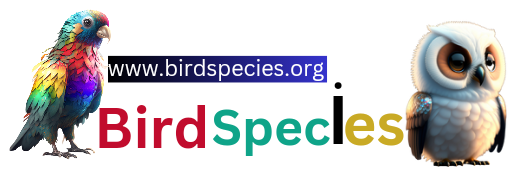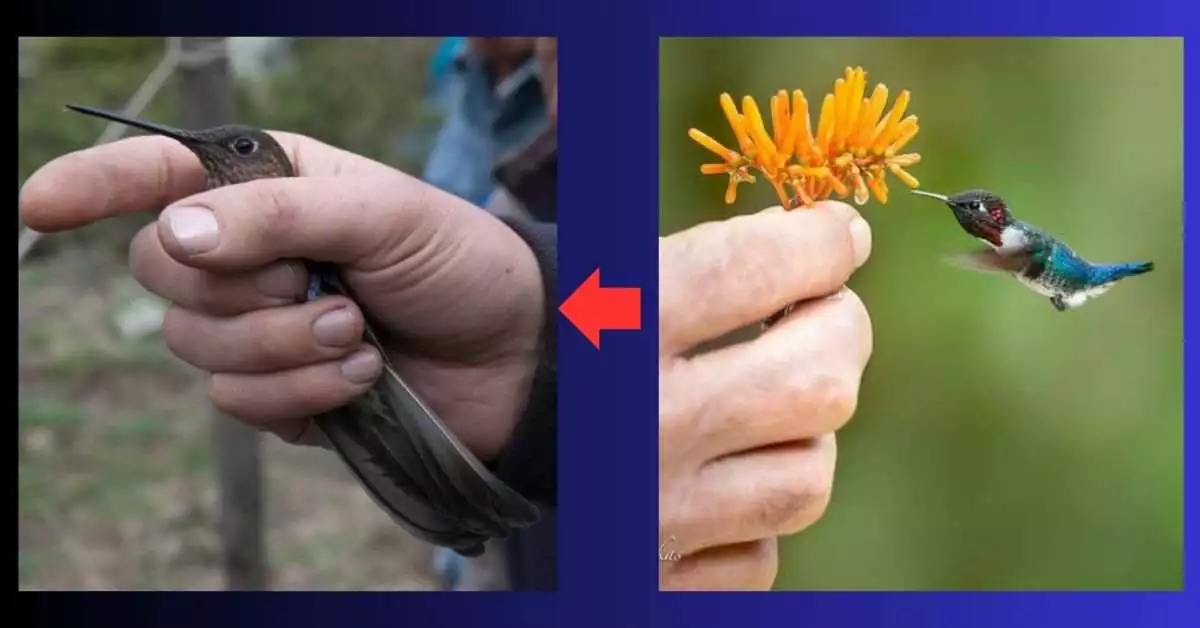
Hummingbirds are the smallest birds in the world. They come in lots of sizes. The tiniest one called the bee hummingbird, is about 5 centimeters (2 inches) long and weighs less than a penny.
The biggest one is the Giant hummingbird, which is about 22 centimeters (8.7 inches) long and weighs a bit more than a couple of tablespoons of water.
Why do they have different sizes? Well, it’s mostly because of what they like to eat and where they live.
Some hummingbirds like to sip nectar from small flowers, so they stay small. Others like bigger flowers, so they grow a bit bigger. And some live in chilly places, so they’re larger to keep warm.
Did you know that size also changes how long they live? Smaller ones usually live only a few years, while bigger ones can live up to ten years.
Hummingbirds Size in Table:
| Hummingbird Species | Size (cm) | Size (in) | Notes |
|---|---|---|---|
| Bee Hummingbird | 5 – 6 | 2.0 – 2.4 | Smallest |
| Bumblebee Hummingbird | 6 – 7.6 | 2.4 – 3.0 | |
| Rufous Hummingbird | 7 – 9 | 2.8 – 3.5 | |
| Calliope Hummingbird | 7 – 9 | 2.8 – 3.5 | |
| Anna’s Hummingbird | 9 – 11 | 3.5 – 4.3 | |
| Costa’s Hummingbird | 9 – 11 | 3.5 – 4.3 | |
| Broad-tailed Hummingbird | 9 – 11 | 3.5 – 4.3 | |
| Black-chinned Hummingbird | 9 – 11 | 3.5 – 4.3 | |
| Ruby-throated Hummingbird | 9 – 11 | 3.5 – 4.3 | |
| Rufous-crested Coquette | 9 – 12 | 3.5 – 4.7 | |
| Violet-crowned Hummingbird | 10 – 13 | 3.9 – 5.1 | |
| Long-billed Starthroat | 11 – 14 | 4.3 – 5.5 | |
| White-necked Jacobin | 12 – 15 | 4.7 – 5.9 | |
| Glittering-bellied Emerald | 12 – 15 | 4.7 – 5.9 | |
| Green Hermit | 13 – 15 | 5.1 – 5.9 | |
| Long-tailed Sylph | 13 – 18 | 5.1 – 7.1 | |
| Sword-billed Hummingbird | 14 – 15 | 5.5 – 5.9 | |
| Giant Hummingbird | 19 – 23 | 7.5 – 9.1 | Largest |
| Andean Hillstar | 13 to 15 | 5.1 to 5.9 |
Know More About These Hummingbirds Size
Here is a brief overview of each hummingbird species, including their food, habitat, where to find them, and behavior.
1. Bee Hummingbird

The Bee Hummingbird is the smallest hummingbird species in the world. They primarily feed on nectar from small flowers.
It is only found in Cuba and the Isla de la Juventud. That means you can’t find this species of hummingbird anywhere in the world except Cuba.
The bee hummingbird is the world’s tiniest bird.
- These Hummingbirds Size: It’s about 2 to 2.4 inches long, which is even smaller than a typical adult’s finger.
- Habitat: These birds are originally from Cuba and the Isla de la Juventud. You can find them in different places like forests, gardens, and by the coast.
- Diet: Bee hummingbirds love to sip nectar from flowers. They are also good at helping plants make new flowers by spreading pollen. Sometimes, they eat small insects and spiders for protein.
- Amazing Skills: These birds can hover in the air like magic, thanks to their super-fast wing flaps.
- Family Life: Bee hummingbirds build small nests using bits of plants and even spider silk. A mom might lay one or two eggs, and she’s the one who looks after the chicks.
- Concerns: Bee hummingbirds are in a bit of trouble because they’re losing their homes and facing other problems. People are working to protect them.
- Bee Hummingbird Facts: Bee Hummingbirds are excellent fliers, with the ability to hover in front of flowers due to their rapid wing beats, which can reach up to 80 beats per second.
They like habitats like open woodlands, gardens, and coastal areas. For its tiny size, it’s known for its quick and agile flight patterns.
2. Rufous Hummingbird

Rufous Hummingbirds mainly eat nectar and sometimes insects. They’re commonly found in North America.
Rufous Hummingbird Some Important Description:
- Rufous Hummingbirds Size: These hummingbirds are quite small, about 3 to 3.7 inches long.
- Color: They’re known for their striking rust-colored feathers, which gleam like fiery embers.
- Range: Rufous Hummingbirds can be found in North America, from Alaska down to Central America, and they migrate long distances.
- Diet: Their main diet is nectar from flowers, and they have a sweet tooth for insects, too.
- Behavior: Rufous Hummingbirds are known for their feisty and territorial nature, often chasing away other birds from their feeding spots.
- Nesting: They make cup-shaped nests using soft materials like plant fibers and spider silk, often attaching them to branches. A female may lay two tiny eggs in her nest.
- Conservation: Rufous Hummingbirds are doing well overall, but their populations in some areas face challenges due to habitat loss. Conservation efforts are important to protect their habitats.
They are mainly found in habitats like gardens, meadows, and forest edges. They’re known for their territorial nature and aggressive behavior toward other hummingbirds.
Related: Most Colorful Hummingbirds: 22 Species with Pictures
3. Calliope Hummingbird

Calliope Hummingbirds primarily feed on nectar from flowers and sometimes insects. Calliope Hummingbird: The Tiny Gem
- Calliopes Hummingbirds Size: This hummingbird is one of the smallest, measuring only about 3 to 3.25 inches in length.
- Color: They’re known for their vibrant colors, often featuring iridescent green and purple feathers, making them a joy to behold.
- Habitat: Calliope Hummingbirds reside in western North America, usually in mountainous areas.
- Diet: Like most hummingbirds, they primarily feed on nectar from flowers but also catch tiny insects for a protein boost.
- Mannerisms: Calliope Hummingbirds are agile fliers, capable of hovering in front of flowers like little helicopters.
- Nesting: They create tiny cup-shaped nests from plant fibers and spider silk, often in shrubs or trees. A female may lay only two eggs at a time.
- Conservation: Their populations are relatively stable, but it’s important to protect their habitats, especially in high-altitude regions.
They inhabit western North America, often near mountain meadows and open areas. They’re known for their distinctive amazing loud call.
Related: 10 Most Beautiful Hummingbirds in the World
4. Anna’s Hummingbird
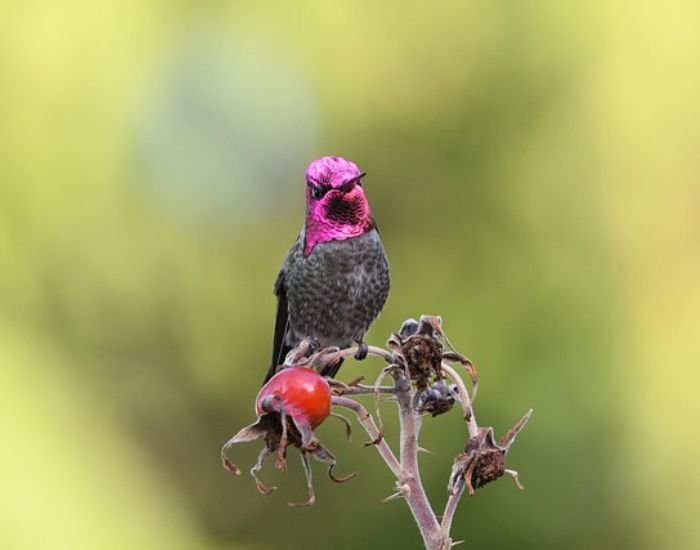
One of the most popular hummingbird species Anna’s Hummingbirds feed on nectar, sap, and insects.
Anna’s Hummingbird: The West Coast Wonder
- These Hummingbirds Size: They are small birds, about 3.9 to 4.3 inches long.
- Color: Males sport vibrant, iridescent pink-red throats that shimmer in the sunlight.
- Habitat: Anna’s Hummingbirds can be found along the western coast of North America, from Alaska to Baja California, Mexico.
- Diet: Nectar from flowers is their primary food, and they also eat tiny insects for protein.
- Characteristics: These birds are known for their skillful mid-air acrobatics and the distinctive noise produced by their rapid wingbeats.
- Nesting: They build cup-shaped nests in trees and shrubs, often incorporating soft materials like moss and feathers.
- Conservation: Their populations are stable and even expanding their range thanks to feeders in gardens, but habitat conservation remains important.
They are mainly found along the western coast of North America. Their main habitats include gardens, parks, and woodlands.
They’re known for their beautiful and colorful plumage that makes them unique among other hummingbird species.
Related: Hummingbirds With Long Tails
5. Costa’s Hummingbird

Costa’s Hummingbirds primarily feed on nectar and sometimes insects. Costa’s Hummingbird: The Desert Dynamo
- Costa’s Hummingbirds Size: Costa’s Hummingbirds are small birds, measuring around 3 to 4 inches in length.
- Color: Males are known for their vivid purple plumage on their heads and throats.
- Habitat: These birds are often found in the southwestern United States and arid regions of Mexico.
- Diet: Their primary food is nectar from desert flowers, and they also consume insects for protein.
- Characteristics: Costa’s Hummingbirds are agile fliers, and the males display striking iridescent colors during their aerial displays.
- Nesting: They construct cup-shaped nests in low shrubs, blending them well with the desert vegetation.
- Conservation: Costa’s Hummingbird populations appear to be relatively stable, but conservation efforts should continue to protect their habitats, especially in the desert.
They inhabit desert areas in southwestern North America. Males are known for their distinct song, while both genders display quick darting flight patterns.
6. Broad-tailed Hummingbird

These hummingbirds mainly feed on nectar from various flowering plants. They’re located in mountainous regions of North America.
Broad-tailed Hummingbird: The Mountain Jewel
- Size: These hummingbirds are small, measuring about 3.25 to 4 inches in length.
- Color: Males feature iridescent green plumage with a distinctive, rounded tail.
- Habitat: They are often found in mountainous and forested areas, particularly in western North America.
- Diet: Nectar from wildflowers is their main food source, along with small insects for protein.
- Traits: Broad-tailed Hummingbirds are agile fliers and make a distinctive whirring sound with their wings in flight.
- Nesting: They build small, cup-shaped nests in trees, using materials like plant fibers and moss.
- Conservation: Populations appear stable, but habitat protection in mountain regions is crucial.
Sometimes they found habitats near streams and meadows. They’re recognized for their distinctive trilling sound during flight.
7. Black-chinned Hummingbird

Black-chinned Hummingbirds depend on nectar and insects for their diet.
Black-chinned Hummingbird: The Subtle Beauty
- Black-chinned Hummingbirds Size: These hummingbirds are small, typically around 3.5 to 4 inches in length.
- Color: Males display a black throat patch, while females have more subdued plumage with a white throat.
- Habitat: They are often found in a variety of habitats, from deserts to woodlands, across the western United States.
- Diet: Nectar from a wide range of flowers is their primary food, supplemented with tiny insects for protein.
- Characteristics: Black-chinned Hummingbirds are skilled fliers, capable of hovering with precision.
- Nesting: They construct small, cup-shaped nests, usually in trees or shrubs, often using plant fibers and spider silk.
- Conservation: Populations seem stable, but habitat preservation remains important.
They’re found in diverse habitats across western North America. They display territorial behavior, often engaging in fierce aerial chases with other hummingbirds.
8. Ruby-throated Hummingbird
One more popular and amazing hummingbird is Ruby-throated Hummingbirds primarily feed on flower nectar and insects.
They inhabit the eastern part of North America. Ruby-throated Hummingbirds size: The Eastern Gem.
- These Hummingbirds Size: These hummingbirds are small, measuring about 3 to 3.5 inches in length.
- Color: Males boast striking iridescent green feathers and a vibrant ruby-red throat.
- Habitat: Ruby-throated Hummingbirds are commonly found in eastern North America, often in gardens and woodlands.
- Diet: Their primary food is nectar from flowers, complemented by tiny insects for protein.
- Characteristics: They are known for their agile flight, hovering, and rapid wing beats.
- Nesting: They build tiny cup-shaped nests in trees, using soft materials like plant fibers and spider silk.
- Conservation: Populations are generally stable, but preserving their habitats is vital.
You can easily find these birds sometimes in gardens, woods, and wetlands. They’re known for their long migrations.
9. Rufous-crested Coquette

Rufous-crested Coquettes feed on nectar from flowers and sometimes insects like other hummingbird species.
The Rufous-crested Coquette is a charming hummingbird that lives in South America.
These Hummingbirds Size: It’s a tiny bird, only about 3 to 4 inches long, and it stands out with its beautiful shiny green feathers and a special reddish crest on its head.
These birds make their homes in the forests of countries like Venezuela, and you can find them down to northern Argentina.
Just like other hummingbirds, they love to drink nectar from pretty flowers, which also helps these flowers make more flowers. Rufous-crested Coquettes are great at flying, and they can hang in front of flowers and drink nectar with their special beaks.
When it’s time to start a family, they build small cup-shaped nests using soft things like plant fibers and spider silk, usually in the lower parts of trees.
We need to be careful with their homes because the places they live are sometimes being cut down or destroyed. So, we must work to protect their homes to keep these beautiful birds around for a long time.
They are mainly found in the tropical forests of Central and South America. Their distinctive behavior includes hovering flight and perching upside down.
10. Violet-crowned Hummingbird

Just like other species of hummingbird Violet-crowned Hummingbirds primarily feed on nectar and insects.
The Violet-crowned Hummingbird is a captivating bird. These little hummingbirds size 3.5 to 4 inches long, have a special violet crown on their heads. You can find them in the desert regions of the southwestern United States and Mexico.
They mainly love sipping nectar from desert flowers and are good at staying in one place in front of the flowers because of their fast wing flaps. They also snack on tiny insects sometimes.
Violet-crowned Hummingbirds are skilled flyers and make tiny nests in trees and shrubs, using plant bits and even spider silk.
Even though they seem to be doing okay, it’s important to make sure their desert homes are safe, so we can keep enjoying these colorful birds.
They’re located in southwestern North America and Central America, often in arid and desert habitats.
Their behavior includes hovering near flowering plants and perching on branches.
11. Long-billed Starthroat

Long-billed Starthroats primarily feed on nectar, which they obtain from flowers by hovering.
The Long-billed Starthroat is an interesting bird. These small hummingbirds size 4 inches long, have a long, slender bill. You can find them in various parts of Central and South America.
Their main diet is nectar from flowers, and they also eat insects. They’re skilled at hovering in front of flowers while feeding.
Long-billed Starthroats often build their tiny nests on tree branches using materials like plant fibers and spider silk. Protecting their habitats is important for their well-being.
These birds are known for their striking and colorful plumage, making them a captivating sight for bird enthusiasts.
They inhabit Central and South America, favoring open woodlands and gardens. They’re known for their long bills and distinctive metal-like plumage.
12. White-necked Jacobin
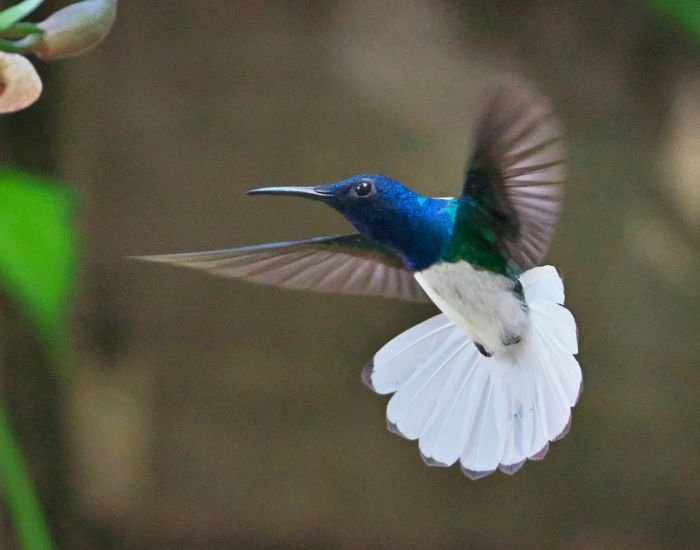
\White-necked Jacobins primarily feed on nectar from a variety of flowers. They inhabit tropical forests of Central and South America.
The White-necked Jacobin is a lovely bird. These lovely hummingbirds size about 4.5 inches long, and it’s known for their beautiful appearance with a white neck and colorful, shiny body.
You can see White-necked Jacobins in Central and South America, especially in tropical forests. They eat nectar from various flowers and also catch insects for food.
When they want to make a home, they build a small nest on tree branches using things like plant fibers and spider silk.
To help these birds, we need to make sure their forest homes are safe and well-preserved. Spotting them in the wild is a treat for any nature lover.
Their behavior includes hovering flight and aggressive interactions with other birds around feeding areas.
That means they are sometimes aggressive and fight with other birds for their food.
13. Glittering-bellied Emerald

Glittering-bellied Emerald
Glittering-bellied Emeralds sustain themselves on nectar and insects. They’re found in Central and South America.
The Glittering-bellied Emerald is a fascinating bird. These small hummingbirds size, measuring about 3.5 inches in length, are known for their eye-catching, shiny green bellies.
You can spot them in Central and South America, often in forests. They love sipping nectar from various flowers and are skilled at hovering in front of blooms while they feed. They also snack on tiny insects for extra protein.
When it’s time to start a family, Glittering-bellied Emeralds build small, cup-shaped nests in trees and shrubs using materials like plant fibers and spider silk.
Protecting their forest habitats is important for the well-being of these birds, allowing us to continue enjoying the glimmer of their vibrant green bellies in the wild.
You can also find them in lowland and foothill forests. They’re known for their shiny, rainbow-like feathers that seem to change colors.
One of the most interesting facts about these birds is they are very skilled at flying in quick and nimble ways.
14. Green Hermit

Green Hermits primarily feed on nectar from flowers. They’re located in tropical forests of Central and South America.
The Green Hermit is an interesting bird. These hummingbirds are on the larger side, with a length of about 4.5 inches. They are recognized by their plain green coloration.
Green Hermits are typically found in Central and South America, often in tropical forests. They have a diet that mainly consists of nectar from various flowers and they’re great at hovering while they feed. They also snack on small insects for extra nourishment.
When it’s time to start a family, Green Hermits build small cup-shaped nests on tree branches using materials like plant fibers and spider silk.
Preserving their forest habitats is crucial for the well-being of these birds, allowing us to continue enjoying their subtle green beauty in the wild.
Their behavior includes hovering flight and unique displays of their long central tail feathers during courtship.
15. Long-tailed Sylph

As for their name, they have very long tails that make them beautiful hummingbirds.
Long-tailed Sylphs feed on nectar from various flowering plants. They inhabit the montane forests of South America.
The Long-tailed Sylph is a striking bird. These hummingbirds’ size is 4.5 inches, and they’re named for their long, elegant tails.
You can find Long-tailed Sylphs in parts of Central and South America, often in mountainous regions. Their primary food is nectar from various flowers, and they’re skilled at hovering while they feed. They also snack on small insects for extra nutrition.
When it’s time to start a family, they create tiny cup-shaped nests on tree branches using materials like plant fibers and spider silk.
Protecting their mountain habitats is important for the well-being of these birds, ensuring we can continue to admire their beauty, especially their long tails, in the wild.
Their most striking feature is their long iridescent tail feathers, which they display during aerial courtship rituals.
16. Sword-billed Hummingbird
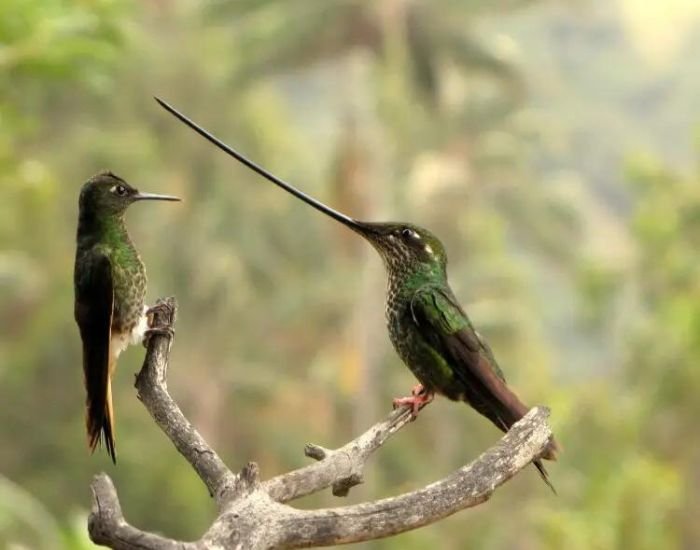
Can you imagine a bird with a sword-like bill? Yes, Sword-billed Hummingbirds primarily feed on nectar from long-tubed flowers.
The Sword-billed Hummingbird is an extraordinary bird. These hummingbirds are medium-sized and measure around 5 inches. They are famous for their exceptionally long, straight bills.
You can spot Sword-billed Hummingbirds in the high-altitude regions of South America, especially in the Andes Mountains.
Their primary diet is nectar from various high-altitude flowers, and they’re known for their ability to hover while feeding. They also consume insects for added protein.
When they’re ready to start a family, they build small, cup-shaped nests in trees, using plant fibers and moss.
Preserving their mountain habitats is essential for the well-being of these unique birds with their incredible bills, ensuring that we can continue to marvel at their distinct features in the wild.
They’re found in high-altitude areas of South America. You can easily find them in South America.
Their most distinctive feature is their long, straight bill, which is longer than their body.
17. Andean Hillstar

Andean Hillstars primarily feed on nectar and insects. They’re located in the high Andes mountains of South America.
The Andean Hillstar is a remarkable bird. These small hummingbirds, around 4 inches in length, are known for their endurance in high-altitude environments.
You can find Andean Hillstars in the Andes Mountains of South America, particularly at lofty elevations. They primarily feed on nectar from various high-altitude flowers and are skilled at hovering while they eat. Insects also make up a part of their diet.
When it’s time to build a home, they create small, cup-shaped nests in rocky crevices or cliffs.
Protecting their mountainous habitats is vital for the well-being of these birds, allowing us to continue admiring their resilience and beauty in the wild, especially in the challenging high-altitude conditions of the Andes.
Their behavior includes hovering flights and visits to high-altitude flowers for food.
18. Bumblebee Hummingbird

Similar to other hummingbirds, the Bumblebee Hummingbird mainly feeds on nectar from flowers.
The Bumblebee Hummingbird is an extraordinary bird. It’s one of the world’s tiniest birds, measuring only about 2 inches in length. The name “Bumblebee Hummingbird” comes from its small size and its hummingbird behavior.
These birds are mainly found in Mexico and Central America. Their primary diet is nectar from tiny flowers, and they are exceptional at hovering in front of these blossoms while feeding. They also eat small insects for added nutrition.
When it’s time to nest, Bumblebee Hummingbirds build the smallest bird nests in the world, often using materials like moss and spider silk. Their nests are about the size of a walnut shell.
Protecting their habitats is essential for the well-being of these incredibly tiny birds, enabling us to continue admiring their remarkable size and behavior in the wild.
Their main habitats include montane forests and shrublands of Central and South America. Its behavior includes hovering flight and rapid feeding.
19. Giant Hummingbird
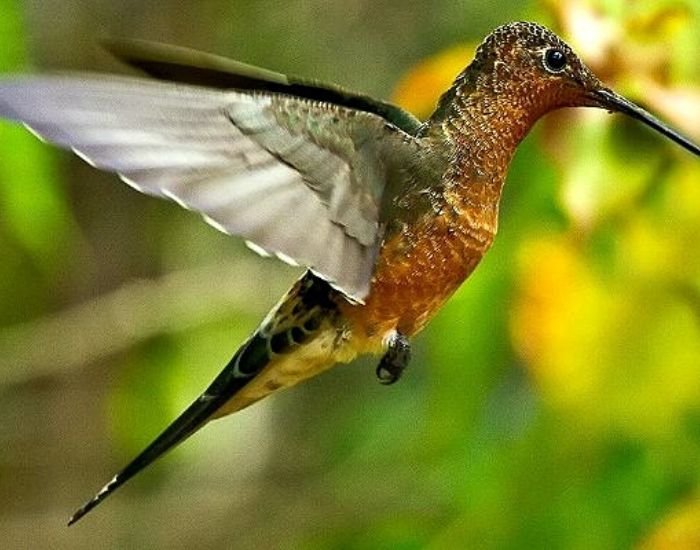
Have you ever thought what is the largest hummingbird species? Yes, the Giant Hummingbird is the largest among hummingbird species.
The Giant Hummingbird, while not the largest overall, is still quite large for a hummingbird.
They feed on nectar and insects and inhabit regions of South America. Their behavior includes fast and direct flight.
The Giant Hummingbird is a unique bird. Despite the name, it’s one of the largest hummingbirds, measuring around 8 inches in length.
You can find Giant Hummingbirds in the high-altitude regions of the Andes Mountains in South America. They primarily feed on nectar from high-altitude flowers, and they’re skilled at hovering while they eat. Insects also make up a part of their diet.
When it’s time to nest, they create small, cup-shaped nests in trees or shrubs using materials like plant fibers and moss.
Preserving their mountain habitats is crucial for the well-being of these larger hummingbirds, ensuring that we can continue to admire their unique size and behaviors in the wild.
Hummingbirds Size (FAQ):
-
How big is a full-grown hummingbird?
A full-grown hummingbird varies in size by species, but they are generally small, with the largest around 5 inches in length and weighing up to 20 grams. The smallest hummingbirds can be as tiny as 2 inches in length.
-
Are there different sizes of hummingbirds?
Yes, there are different sizes of hummingbirds. Hummingbirds come in various sizes, with the smallest species, like the Bee Hummingbird, being only a few inches long, while the largest species can reach up to about 5 inches in length. The size of a hummingbird can vary depending on its species, and they are known for their small and lightweight nature.
-
Are hummingbirds big or small?
Hummingbirds are generally small birds. They are known for their small size and lightweight nature. The size of a hummingbird varies by species, but even the largest hummingbirds are relatively small compared to many other bird species. Their size typically ranges from about 2 to 5 inches in length, making them some of the smallest birds in the world.
-
Do hummingbirds grow larger than bees?
No, hummingbirds are typically larger than bees. Hummingbirds are small birds, with the smallest species, like the Bee Hummingbird, measuring about 2 to 2.4 inches in length. Bees, on the other hand, are insects, and they are generally smaller, with many species measuring around half an inch to 1.5 inches in length. So, in terms of size, hummingbirds are generally larger than bees.
-
What looks like a hummingbird but larger?
If you’re looking for a bird that resembles a hummingbird but is larger, you might be thinking of sunbirds. Sunbirds are small to medium-sized birds found in Africa and Asia, and they share some visual similarities with hummingbirds, such as long bills and vibrant plumage. While sunbirds are larger than hummingbirds, they are still relatively small in the bird world. They are often mistaken for hummingbirds due to their similar feeding habits and appearance.
Conclusion
In summary, the size of a hummingbird is a really interesting and intricate thing to explore. What makes them big or small involves stuff like what they eat, where they live, and the climate they’re in. This size even influences how they act, how long they live, and how healthy they are.
The variety in their sizes is one of the things that make these birds super special. Regardless of how big or small they are, all hummingbirds are truly amazing in how they fly and adapt. They play a big role in nature, and they must keep thriving.
